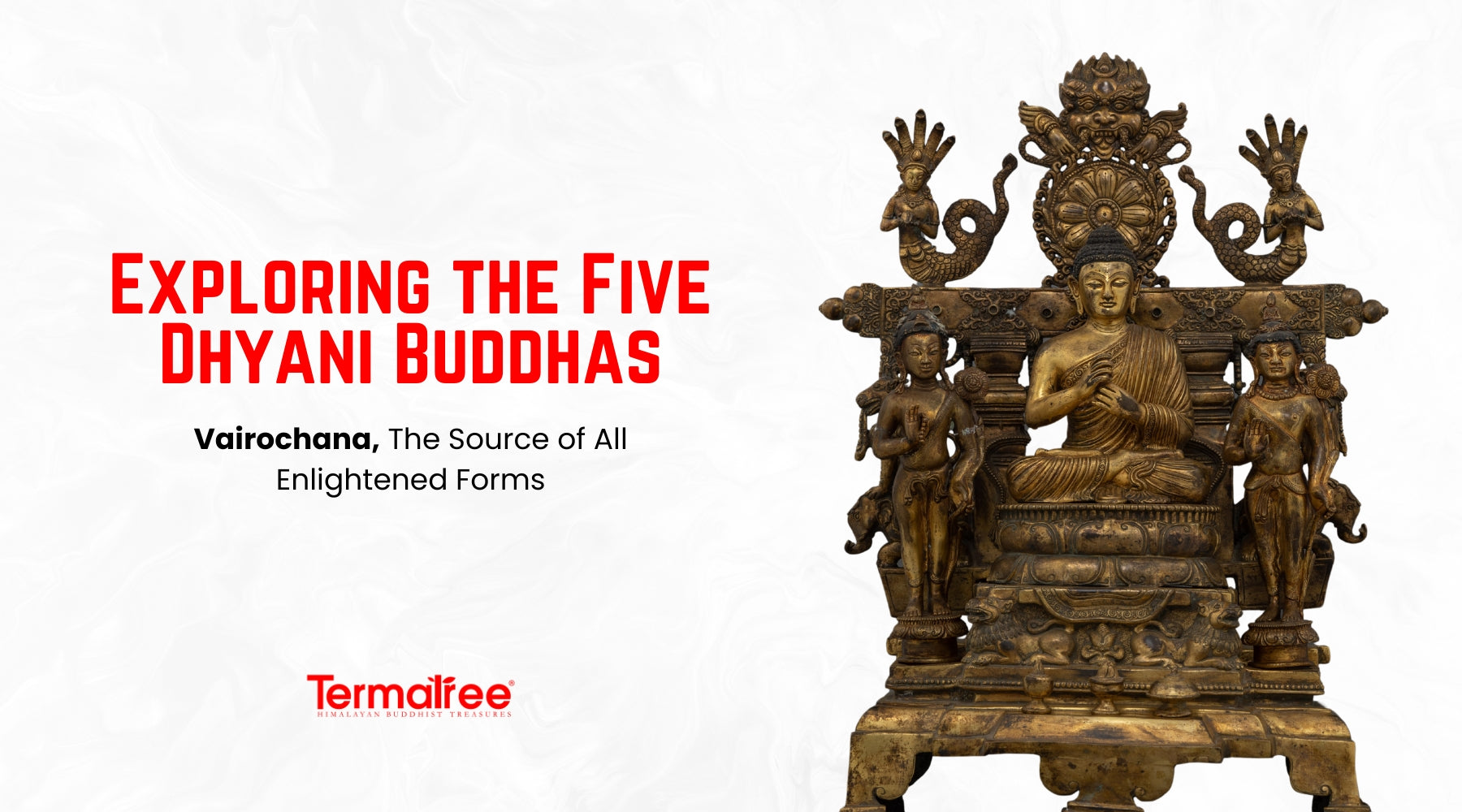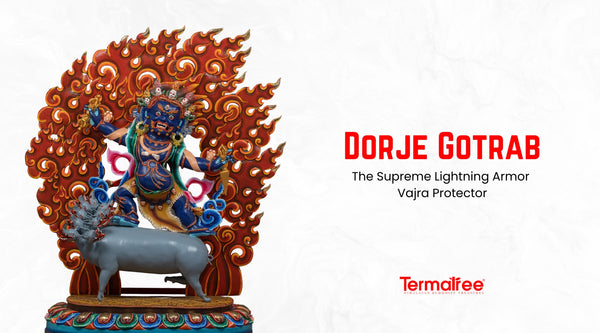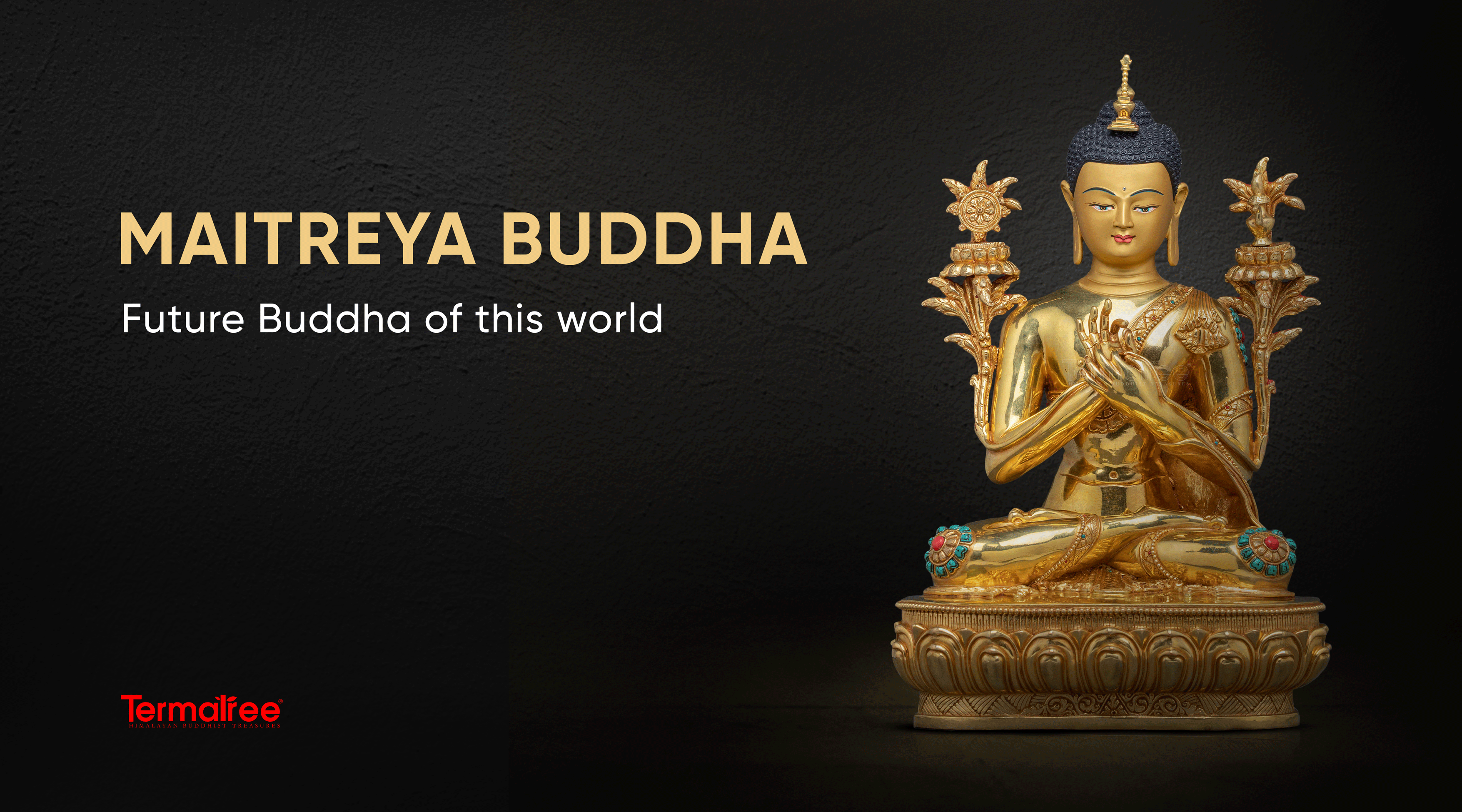Meet Vairochana: The Beginning of Our Journey into the Five Dhyani Buddhas
In the expansive, complex context of Tibetan Buddhism Vairochana Buddha embodies the spiritual growth and transformation symbolizing the pure, unchanging and ultimate quality of reality. Known also as the Cosmic Buddha or Great Illuminator, and more than a celestial figure —Vairochana (Sanskrit: वैरोचन) is the brilliant center of the Five Dhyani Buddhas — the mandala of awakened wisdom. Fundamentally, his centrality is indicative of the integrated aspect of all opposites. He represents the Dharmadhatu or the limitless space of ultimate reality or truth. His brilliant white color, the perfect posture of meditation, and all other aspects of his form references an enlightened state void of form, time, and self. His existence reveals one's ability to realize enlightenment as a natural state pervading everything.
The term "Vairocana" translates to "the luminous one," which emphasizes the clear light and expansive awareness that is the foundation of all reality. Unlike historical Buddhas like Shakyamuni, who took birth, taught, and realized parinirvana, Vairocana transcends time, and does not know time. He is transcendental, timeless, and all-pervasive. He is not limited to our world system or a time period, but is the primordial source of all enlightened activities throughout the multiverse. He is also the locus of the five Dhyani Buddhas — Akshobhya, Ratnasambhava, Amitabha, and Amoghasiddhi — explaining and highlighting their wisdoms and knowledge into a comprehensive truth. Vairochana does not just show the way to liberation but is, in fact, the field of awakening.
Vairochana in the Five Dhyani Buddha Mandala
In the holy mandala of the Five Dhyani Buddhas, Vairochana occupies the center position which not only signifies unity and space, but also the timelessness of that which is absolute. His position conveys far more than space; it is spiritual. Holding both the beginning and the end of all enlightened qualities, He is the embodiment of Dharmadhatu Wisdom—the direct realization that all phenomena arise and dissolve from ultimate truth and are ultimately inseparable from that reality. Vairochana integrates the distinct aspects of awakened wisdom portrayed by the other Dhyani Buddhas in the mandala: Akshobhya (East) as mirror-like wisdom; Ratnasambhava (South) as equanimity; Amitabha (West) as discernment; and Amoghasiddhi (North) as all-accomplishing wisdom-- into a single, brilliant awareness. In the mandala, we can understand Vairochana to be the non-dual center around which the other energies are co-instantiated, and to which they dissolve or return, just as rays of sunlight emanate from and return to the sun.
The centered position of Vairochana reflects his inspirational importance and representation of the Dharmakaya (the formless body of truth). He is the axis mundi, the center of the cosmos whose reality destroys the illusion of separation. For practitioners, meditating on this buddha is an invitation to encounter the purity of the Dharma realm — an experience marked by a luminous clarity where form and emptiness, method and wisdom, and appearance and reality are fused. He communicates that phenomena do not create distractions to truth, that they actually fully express truth. The mandala represents the perfected cosmos; Buddhas are a reflection of Vairochana, who can lead practitioners beyond duality to vacuous, calm, all-inclusive awareness of reality past distinctions.
Iconography: What Does Vairochana Look Like?

1. Body Color and Symbolism
Vairochana is most often depicted in the color white, a color that symbolizes pure consciousness, clarity and non-duality. The color of his body, unlike the colored representations of the other Dhyani Buddhas, emphasizes Vairochana's all-inclusive nature. He encapsulates the essence of all Buddhas; he is said to include the essence of all Buddhas.
White also represents the light of the mind decontaminated of ignorance his primary karmic delusion to transmute. He sometimes radiates light in ten directions in some mandalas to show he is the source and center from which wisdom rays emanate in all directions.
2. Mudra (Hand Gesture)
Vairochana is usually portrayed with the Dharmachakra Mudra (gesture of turning the Wheel of Dharma) meaning that both hands are in front of the chest with the thumbs and index fingers meeting to form wheels. This mudra represents the three interrelated themes:
-
the transmission of the new teachings of the Buddha's path
-
the uniting of wisdom and method
-
the initiation of cosmic truth through spiritual transmission.
Rarely will he be shown with the Bhumisparsha Mudra (earth-touching gesture), however, since that is less typical in Vajrayana.
3. Symbol: The Dharma Wheel (Dharmachakra)
His sacred symbol is the Dharma Wheel (Dharmachakra) a powerful representation of the Eightfold Path, spiritual law, and unfettered movement of truth. In thangkas or statues, the Wheel may be held, painted next to the throne, or emanating from his body. It signifies the continuous movement of spiritual understanding in the life of the practitioner.
The eight spokes of the wheel map onto the eight consciousnesses and thus Vairochana is further connected to the purification of perception.
4. Mount and Throne
Sometimes, he is depicted seated on a lion; the lion represents royal majestic fearlessness and a power to proclaim the truth. The lions in Buddhist art signify the announcing of Dharma, just as Vairochana's realization proclaims truth through illusion, as with all the Dhyani Buddhas. The lion throne signifies his supreme kingship, sitting at the center of the mandala.
He may also be shown with a Torana-style throne-back or an aureole of light, referencing his universal aspect as a teacher for all realms, and all beings.
5. Crowned vs. Uncrowned Forms
For yogic and tantric applications, he is often shown as a crowned Buddha, with celestial ornamentation, silks, and a five leafed crown. The five leafed crown represents the being of all five Dhyani Buddhas within him.
However, in any of the sutra based or Zen contexts, especially in China and Japan where he can appear chastely monastic or uncrowned, he represents the identity of Mahavairochana (especially in Shingon), the universal Buddha from which all teachings arise.
Symbolism: What Vairochana Represents
Vairochana carries a tremendous wealth of meaning, and each layer represents a deeper level of spiritual practice:
Element: Space (Ether)
Space (ether) is not experienced like earthy, watery, fiery, or windy solidity, but it contains them all. All of this reflects Vairochana's experience of existence in his nature -- formless, and yet the basis for form.
Poison Transformed: Ignorance/Delusion
The poison of avidya, ignorance, the underlying condition when one fails to be able to perceive things honestly, is transformed into Dharmadhatu Wisdom. This is the inherent wisdom of Vairochana that reflects genuine understanding of interdependence and emptiness of all phenomena.
Wisdom: Dharmadhatu Wisdom
This is the wisdom that perceives, and relates to things, not as isolated objects, but as part of a vast luminous inter-being, the actual nature of reality. This is the essence of enlightened experience.
Vairochana in Buddhist Scriptures

In an overwhelming amount of sacred Buddhist literature, Vairochana's divine stature and central cosmic capacity are always highlighted, often giving insights that can apply to personal experience as well as a wider spectrum of universal experience. For example, in the Brahma Net Sutra, Vairochana sits on a lotus pedestal under an umbrella of infinite flowers, standing above many other Shakyamuni Buddhas emerging from "pure water, which does not cause distress". This vision evokes the deity as the source of all Buddhas.
In the Flower Garland Sutra (Avatamsaka Sutra), he is shown to be the fundamental reality responsible for all things, while Mahayana teachings sometimes refer to him as the Dharma Body (Dharmakaya) of the historical Buddha. In the Samantabhadra Meditation Sutra, he is in the peaceful place "Always Tranquil Light" as the expression of the unchanging nature of absolute truth. The existence of the eternal Buddha is referred to in the Lotus Sutra, whose wisdom teachings are seen as transgressing death. In the Mahavairocana Sutra, he is the source of all Buddhas, who provides Vajrasattva transmissions of tantras beyond conceptual phrases for the direct realization of the Dharma.
The Practice and Visualization of Vairochana
In Vajrayana Buddhist practice, practitioners will visualize Vairochana in the center of a sacred diagram, called a "mandala," for more advanced tantric meditations. As the embodiment of the Dharmadhatu Wisdom, he represents spacious, all-encompassing awareness beyond duality. Practitioners will often visualize and recite mantras to dissolve ignorance, purify delusions, and create inner spacious clarity. When we look at the different forms of Vairochana mantras, one mantra will be the essential prayer for its simplicity, ease and, effectiveness:
“Om Vairocana Om”
Chanting the above mantra helps align our internal energy with clarity, purity and, spiritual light; and moves us away from a fragmented perception, to awakened perception, in the oneness of activity.
More than a simple recitation, the Vairocana mantra is also viewed as a magical vibrational substance. Repeated chanting (in both VAIROCANA and EM mantra forms) is said to clear away the pollutants in our minds and our bodies, which encourages more solid states of deep inner peace, calmness and mental steadiness. These teachings say that repeated chants help cleanse spiritual obstacles and the negative energy within and around us and replace it with positive, affirmative and affirmative life forces. Many Vajrayana people also believe that regular chanting promotes physical and mental health, emotional stability, and a healthy balance in life. At another level, chanting creates a powerful karmic connection with the enlightened energy of Vairochana's mind streams, and while beneficial and auspicious for the practitioner, can also function as a protective buffer from harmful and violent outer forces that distract from awakening. a moment of chaos, confusion or a restless, worldly mindset, the mantra overstakes our thinking into awareness maintaining us back into stillness, stability and luminosity at the essence of reality.
Vairochana and the Body: Head and Central Channel
In tantric anatomy, this buddha is closely related to the top of the head's crown chakra. This position is intentionally chosen and echoes his important spiritual role as the starting point of awakening. The crown chakra is our connection to higher consciousness. Similarly, he, as the None Too Subtle Buddha, embodies the entry to profound insight and universality of clarity. From that position, the energy descends the central energy channel (avadhuti) down the spine, connecting all chakras, facilitating balance and harmony of the subtle energies of the body. This central energy channel represents his mandalic location at the center, functioning as a channel and axis of the wisdoms of many directions to flow together into one. Vairochana occupies a position at the energetic heart of the tantric body, embodying the productive blending of inner and outer dimensions of realization.
Vairochana and the Other Buddhas: Interconnected Wisdom
Vairochana's full meaning cannot be understood alone—only by seeing his interdependence with the four remaining Dhyani Buddhas. Each embodies a transformative wisdom that reflects an awakened mind:
-
In the East, Akshobhya transforms anger into mirror-like wisdom, able to mirror all phenomena, without distortion.
-
In the South, Ratnasambhava transforms pride into the wisdom of equality, reflecting all sentient beings, without bias.
-
In the West, Amitabha transforms attachment and desire into discriminating wisdom, engaging with the uniqueness of every experience.
-
In the North, Amoghasiddhi transforms jealousy into all-accomplishing wisdom, the energy of fearless action.
Nevertheless, these forces are not competing entities vying for supremacy or priority. Rather, they all circle this deity, who acts as their central pivot, unifying each of their wisdoms into the Dharmadhatu Wisdom, the all-encompassing insight that sees the true nature of all things as non-dual and beyond concepts. The deeper Vajrayana teachings explain that the Five Buddhas are not outside gods and goddesses, but mirrors of a person's own enlightened potential—these are manifestations of the original cause, the Buddha-nature that exists in all sentient beings. Vairochana's position also suggests that we can honor the cosmic order of enlightened wisdom, and manifest it as its living expression in ourselves, thus continuing without interruption into the path of integration, recognition, and liberation.
Conclusion: Embodying the Wisdom of Vairochana
Vairochana Buddha does not only serve as the symbolic center of a mandala — He embodies the radiant potential for awakening that exists in all of us. His location at the center of the Five Dhyani Buddhas is not just a cosmic location — it is a deep and profound truth about our own being. Vairochana conveys the Dharmadhatu Wisdom — the knowledge and wisdom that all appearances, thoughts, and emotions arise inseparably within the hosomous luminosity of mind's spaciousness. His pure white form is a symbol of clarity, of transcendence — altogether free from either defilement or dualistic confusion. It is only by studying this deity’s iconography and position with Tantric cosmology, practitioners can potentially find and recognize the underlying unchanging awareness that exists behind the flow of thoughts and emotions.
Meditating on Vairochana means going back to the source — to the original light of consciousness unsoiled by desire, anger, or ignorance. His teachings gently remind us that real liberation is not found outside of ourselves, but at the still center of our awareness. When, through practice, the crown chakra is open and the central channel is energized, practitioners are aligned within themselves that matches up with the cosmic structure of a mandala. In this way, he is both a deity to contemplate, and a stance to embody. He teaches us that the ultimate reality, the Dharmakaya, cannot be reached through effort, but rather through recognition of what is already present; the boundless, luminous nature of our own Buddha-mind.





